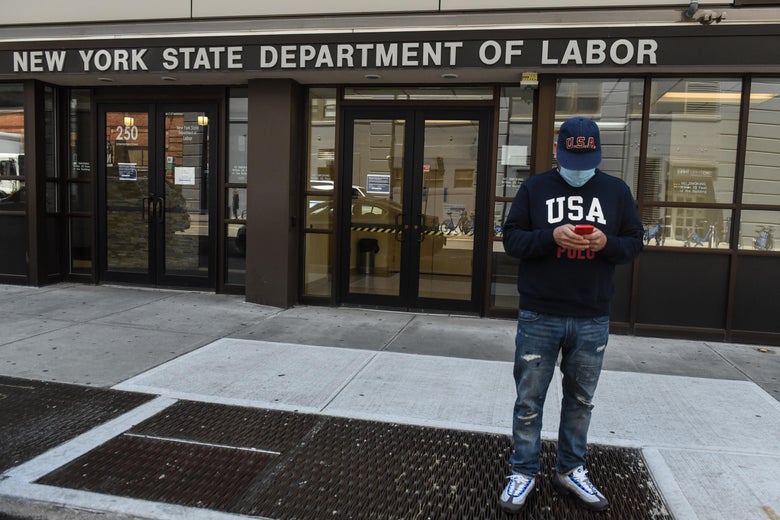
A man stands in front of the closed offices of the New York State Department of Labor on Thursday in Brooklyn.
Stephanie Keith/Getty Images
Thanks to the coronavirus crisis, the United States is now facing its highest unemployment rate since the Great Depression.
The economy shed 20.5 million jobs in April, and the official unemployment rate rose to 14.7 percent—its highest peak since the government began tracking the modern data series in 1948, the Bureau of Labor Statistics reported on Friday.
The Federal Reserve Bank of St. Louis
April’s numbers are more on par with the 1931 unemployment rate, based on data drawn from the Historical Statistics of the United States.1 For the moment, we’re living in Hooverville.
Jordan Weissmann/Slate
But today’s headline figure may understate the actual extent of joblessness at the moment. In a FAQ accompanying today’s report, the BLS explained that due to a data collection mistake, up to 8.1 million Americans may have been categorized as employed but not at work, when they likely should have been classified as unemployed or on a temporary layoff. If you factor those individuals in, the April unemployment rate would jump to about 19.5 percent, the government’s statisticians wrote. That would place us roughly in 1932 to 1933 territory.
Jordan Weissmann/Slate
If all this weren’t depressing enough for you, remember: Millions more Americans have filed unemployment claims since the middle of last month, when this data was actually collected. The picture we’re looking at now is still relatively bright compared to the current reality.
One notable thing about April’s job losses was that they occurred across virtually all industries. The largest chunk by far was in leisure and hospitality (including hotels and restaurants), which saw payrolls decline by more than 7.6 million, or more than one-third of the total. Retail contributed another 2.1 million. But basically every corner of the labor market—from construction to manufacturing to health care to professional services like law—saw declines. There were a handful sub-sectors that saw small increases, but the only big gains were supercenters and warehouse clubs (think Walmart, Target, and Costco). We’re not looking at a few industries that have frozen up, but really a whole economy.
It’s not exactly a shock that we’re facing mass unemployment at a moment when entire states and industries are effectively shut down. But the new jobless figures do suggest that the government’s coronavirus response has fallen short in at least one key way. Much of the economic relief bill Congress passed in March, the CARES Act, was designed to keep workers attached to their jobs where possible. The fact that we are now staring at Great Depression–like unemployment numbers anyway should be regarded as a failure. Yes, it’s likely that even more people would be out of work were it not for efforts like the Paycheck Protection Program. And it’s possible that there has been some rehiring as businesses received their government aid. But the continued flood of unemployment claims suggest that things are, if anything, getting worse rather than better.
The one reason these figures are not a complete catastrophe is that Congress created extremely generous $600-per-week federal unemployment benefits. As a result of those, many Americans will receive more in government aid each week than they were earning at their jobs. States have had difficulty coping with the avalanche of claims, and many people have had to wait weeks to receive their money, if they haven’t been prevented from applying entirely by crashing websites. But as of April 18, almost 19 million Americans at least had their applications processed. Hopefully, most of the jobless are actually receiving some substantial help by now.
The federal unemployment benefits are only scheduled to last through the end of July, however. If they expire and people still aren’t ready for a return to work (or shopping or eating out), families are going to find themselves in increasingly desperate financial situations, and the economy will likely sink further into trouble.
In the end, this is just one month’s jobs report. What made the Great Depression the Great Depression was the yearslong slog through economic devastation. The question for us is whether the government can finally contain this virus and engineer a reasonably fast economic recovery. Unfortunately, it’s not at all clear that it will. Republicans in Congress currently don’t appear to have much appetite to pass further significant relief or stimulus measures, such as fiscal aid to states; extended federal unemployment benefits; or a bigger, better wage subsidy program to keep people connected to their work. Meanwhile, the White House seems to betting its response on Jared Kushner’s ability to speed up development of a vaccine, which … God help us. If none of this changes soon, there’s a good chance we really will be headed for a long depression of our own.
1This data series counts Americans who were put to work through New Deal programs like the Works Progress Administration as employed. Some conservative historians count them as unemployed, basically because it helps them paint Franklin D. Roosevelt’s efforts to combat the Depression as a failure.
Readers like you make our work possible. Help us continue to provide the reporting, commentary, and criticism you won’t find anywhere else.
Join Slate Plusfrom Slate Magazine https://ift.tt/3chSIBN
via IFTTT
沒有留言:
張貼留言